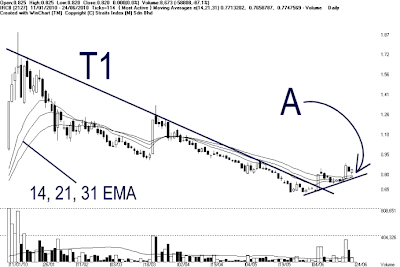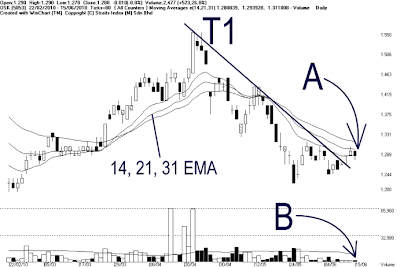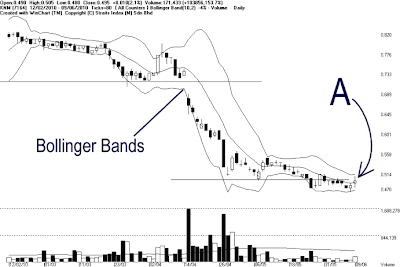BJCorp – 3395: Still in downtrend.
Chart 1: BJCorp – 3395 (30/03/2010~21/07/2010)
As indicated by chart 1, ever since breaking below the 14, 21, 31 EMA in April, price of Bjcorp has been staying below the L1 downtrend line as well as the 14, 21, 31 EMA, despite many technical rebound, the downtrend remains.
Please note that the characteristic of a downtrend, which is Lower-highs. It means that every time price rebound, its rebound peak is lower than the previous rebound peak.
Technically, as long as price staying below either the L1 line or the 14, 21, 31 EMA, it is not a good time to buy. Try think this, for those who bought during this downtrend, he or she must have thought that the day they bought was the lowest of the downtrend, or else, knowing that price could go lower, they won't dare to buy at all. However, how many people had guessed wrongly? Only to realize that they were buying too soon.
Nevertheless, support for Bjcorp is at RM1.00 psychological level, and there is a chance for price to rebound or consolidate at this level. However, a valid buy signal is only when price could successfully break away the L1 downtrend line, then a formation of a higher-low with strong volume.
| 4 Q Rolling PER | 53.66 times | Dividend Yield | 0.91 % |
| Dividend | Dividend Yield | Net Profit Ratio | |
| 30/4/2010 | 1 sen | 0.79 % | 1.23 % |
| 30/4/2009 | 3.35 sen | 3.99 % | -0.83 % |
| 30/4/2008 | 9.00 sen | 8.11 % | 17.20 % |
| 30/4/2007 | 0 sen | 0 % | 5.75 % |
| 30/4/2006 | 0 sen | 0 % | -24.33 % |
Table 1: BJCorp – 3395, yearly dividend, dividend yield and net profit ratio
Gamuda – 5398: Still in uptrend.

Chart 2: Gamuda – 5398 (31/03/2010~21/07/2010)
As shown on chart 2, price of Gamuda broke above the 14, 21, 31EMA on the 4thof June, and since then, the uptrend is still intact. Despite a correction on the 29thof June, price of Gamuda remains above the 14, 21, 31 EMA, and volume also increased strongly when price rebound from the 14, 21, 31 EMA, suggesting more inflow of fresh buying interests to off set the selling pressure. Therefore, the uptrend resumed.
Technically, the 14, 21, 31 EMA is still the dynamic support for Gamuda, and provided that price of Gamuda is still supported by the 14, 21, 31 EMA, it is a good idea to hold on to the stocks, until price should break below the 14, 21, 31 EMA, then it would be a signal to take profit or to cut loss.
For the mean time, Gamuda is testing the RM3.44 resistance level, which is an important resistance for it is the peak of 2009. If price should break above this level, it would be making a 1 year new high. Next resistance is at RM4.00while the support is at 14, 21, 31 EMA.
| 4 Q Rolling PER | 27.36 times | Dividend Yield | 2.38 % |
| Dividend | Dividend Yield | Net Profit Ratio | |
| 31/7/2009 | 8 sen | 2.38 % | 7.10 % |
| 31/7/2008 | 25 sen | 9.26 % | 13.52 % |
| 31/7/2007 | 46 sen | 5.90 % | 12.23 % |
| 31/7/2006 | 16 sen | 4.57 % | 13.74 % |
| 31/7/2005 | 16 sen | 3.43 % | 17.26 % |
Table 2: Gamuda – 5398, yearly dividend, dividend yield and net profit ratio
Review Last week's case study: Zelan – 2283: Break away downtrend.
Chart 3: Zelan – 2283 (27/10/2009~30/06/2010)
As indicated by A, price of Zelan breaks above the L1 downtrend line, breaking away from the downtrend. Therefore, the 14, 21, 31 EMA is now serving as the dynamic support for Zelan. Technically, provided that price is still above the EMA, the uptrend shall remains intact.
For a healthy uptrend, there must be healthy corrections, but volume during the correction should not be high, this way it suggests that the selling pressure is not huge. Lastly, after the correction, price has to rebound from the 14, 21, 31 EMA with strong volume, then it would form a higher-low, thus a good chance to resume its uptrend.
In other words, if price is still being supported by the 14, 21, 31 EMA, then it is a good idea to keep the stock, until price should break below the 14, 21, 31 EMA, then it would be a signal to cut loss or to take profit. Nevertheless, immediate resistance for Zelan is at RM0.685~ RM 0.69, next resistance is at RM0.81 level. 14, 21, 31 EMA is the current dynamic support.
| 4 Q Rolling PER | 0 times | Dividend Yield | 0% |
| Dividend | Dividend Yield | Net Profit Ratio | |
| 31/3/2010 | 0 sen | 0% | -24.77% |
| 31/3/2009 | 5 sen | 8.93% | -7.33% |
| 31/3/2008 | 14 sen | 6.76% | -1.30% |
| 31/3/2007 | 15 sen | 1.88% | 12.60% |
| 31/3/2006 | 10 sen | 2.96% | 14.47% |
Table 3: Zelan – 2283, yearly dividend, dividend yield and net profit ratio
Conclusion:
To buy only when price is rising, is a simple idea, which is to make sure that when buying, the stock is resuming its uptrend after a correction. However, it is hard to do, because the entry price is usually higher, and it makes most investors uncomfortable to buy stocks at a higher price. But remember, it is the price different that we want, and the direction, not the price.
Copyright © 2009 Straits Index (M) Sdn BhdImportant Disclaimer:These content provided by Straits Index (M) Sdn Bhd is solely for education and information purposes only, and do not suggest any investment advices. All information displayed are believed to be accurate and reliable. Interpretation of the data or analysis is at the reader's own risk. Straits Index (M) Sdn Bhd reserves the rights but obligations to update, admen, or even terminate the materials. 重要声明:以上的内容由海峡指数(马)私人有限公司提供,纯粹是教育性质, 并不是任何的投资忠告。所有资料显示认为是准确和可靠的。对数据或分析的解释和用途是在于用户自己的风险。海峡指数(马)有限公司持有保留及义务更新,甚 至终止材料的权利。



























